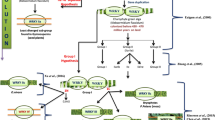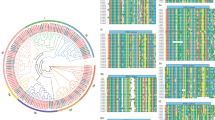Abstract
Latex of Hevea brasiliensis (Willd. ex A, Juss.) Mull. Arg. (Brazilian rubber tree) contains 30–50% (w/w) of natural rubber (cis-1,4-polyisoprene), which is an important raw material for many industrial uses. In order to gain insights into the molecular events occurring in latex, we analyzed more than 20,000 cDNA-AFLP-based TDFs (transcription-derived fragments) and 1176 ESTs. The results revealed several novel features of the latex transcriptome. First, the repertoire of the genes expressed in latex is unique. Only seven gene families accounted for more than 51% of the latex transcriptome. Among them, two of the most abundant ESTs were the genes encoding rubber particle proteins REF (rubber elongation factor) and SRPP (small rubber particle protein), comprising 29% of the total ESTs. Unexpectedly, several genes involved in the rubber biosynthesis were expressed at low levels in the latex. In fact, genes encoding cis-prenyltransferase (CPT), a potential candidate for rubber polymerase, were not present in the EST pool because of their low expression level. However, we were able to clone four full-length cDNAs by screening the same latex cDNA library used in the EST analysis and confirmed their enzyme activity in vitro. The second most abundant transcripts were defense- or stress-related genes, suggesting that defense is one of the functions of laticifers. Finally, the presence of the non-mevalonate DXP/MEP pathway for IPP synthesis in latex was noted by up-regulation of the 1-deoxy-D-xylulose 5-phosphate synthase gene.
Similar content being viewed by others
References
Altschul, S.F., Gish, W., Miller, W., Myers, E.W. and Lipman, D.J. 1990. Basic local alignment search tool. J. Mol. Biol. 215: 403–410.
Bach, T.J. 1995. Some new aspects of isoprenoid biosynthesis in plants: a review. Lipids 30: 191–202.
Bachem, C.W., van der Hoeven, R.S., de Bruijn, S.M., Vreugdenhil, D., Zabeau, M. and Visser, R.G. 1996. Visualization of differential gene expression using a novel method of RNA fingerprinting based on AFLP: analysis of gene expression during potato tuber development. Plant J. 9: 745–753.
Backhaus, R.A. 1985. Rubber formation in plants: a mini-review. Israel J. Bot. 34: 283–293.
Balch, W.E., Kahn, R.A. and Schwaninger, R. 1992. ADP-ribosylation factor is required for vesicular trafficking between the endoplasmic reticulum and the cis-golgi compartment. J. Biol. Chem. 267: 13053–13061.
Bonner, J. and Galston, A.W. 1947. The physiology and biochemistry of rubber formation in plants. Bot. Rev. 13:543–596.
Borden, K.L. and Freemont, P.S. 1996. The RING finger domain: a recent example of a sequence-structure family. Curr. Opin. Struct. Biol. 6: 395–401.
Bouteau, F., Dellis, O., Bousquet, U. and Rona, J.P. 1999. Evidence of multiple sugar uptake across the plasma membrane of laticifer protoplasts from Hevea. Bioelectrochem. Bioenerg. 48: 135–139.
Chye, M.L. and Cheung, K.Y. 1995. Beta-1,3-glucanase is highly-expressed in laticifers of Hevea brasiliensis. Plant Mol. Biol. 29: 397–402.
Chye, M.L., Kush, A., Tan, C.T. and Chua, N.H. 1991. Characterization of cDNA and genomic clones encoding 3-hydroxy-3-methylglutaryl-coenzyme A reductase from Hevea brasiliensis. Plant Mol. Biol.16: 567–5
Cornish, K. 2001. Similarities and differences in rubber biochemistry among plant species. Phytochemistry 57: 1123–1134.
Davis, W. 1997. The rubber industry’s biological nightmare. Fortune 4: 86–95.
Dennis, M.S. and Light, D.R. 1989. Rubber elongation factor from Hevea brasiliensis. Identification, characterization, and role in rubber biosynthesis. J. Biol. Chem. 264: 18608–18617.
Durrant, W.E., Rowland, O., Piedras, P., Hammond-Kosack, K.E., and Jones, J.D. 2000. cDNA AFLP reveals a striking overlap in race-specific resistance and wound response gene expression profiles. Plant Cell 12: 963–977.
Dussourd, D.E. and Eisner, T. 1987. Vein-cutting behavior: insect counterploy to the latex defense of plants. Science 237: 898–901.
Eisenreich, W., Schwarz, M., Cartayrade, A., Arigoni, D., Zenk, M.H. and Bacher, A. 1998. The deoxyxylulose phosphate pathway of terpenoid biosynthesis in plants and microorganisms. Chem. Biol. 5: R221–R233.
Ewing, B., Hillier, L., Wendl, M.C. and Green, P. 1998. Base-calling of automated sequencer traces using Phred. I. Accuracy assessment. Genome Res. 8: 175–185.
Færgeman, N.J. and Knudsen, J. 1997. Role of long-chain fatty acyl-CoA esters in the regulation of metabolism and in cell signalling. Biochem. J. 323: 1–12.
Farrell, B.D., Dessourd, D.E. and Mitter, C. 1991. Escalation of plant defenses: do latex and resin canals spur plant diversification? Am. Nat. 138: 881–900.
Giordani, R., Siepaio, M., Moulin-Traffort, J. and Regli, P. 1991. Antifungal action of Carica papaya latex: isolation of fungal cell wall hydrolysing enzymes. Mycoses 34: 469–477.
Giordani, R., Cardenas, M.L., Moulin-Traffort, J. and Regli, P. 1996. Fungicidal activity of latex sap from Carica papaya and antifungal effect of D(+)-glucosamine on Candida albicans growth. Mycoses 39: 103–110.
Giordani, R., Gachon, C., Buc, J., Regli, P. and Jacob, J.L. 1999. Antifungal action of Hevea brasiliensis latex. Its effect in combination with fluconazole on Candida albicans growth. Mycoses 42: 465–474.
Gish, W. and States, D.J. 1993. Identification of protein coding regions by database similarity search. Nature Genet. 3: 266–272.
Goyvaerts, E., Dennis, M.S., Light, D.R. and Chua, N.H. 1991. Cloning and sequencing of the cDNA encoding the rubber elongation factor of Hevea brasiliensis. Plant Physiol. 97: 317–321.
Han, K.-H, Shin, D.H., Yang, J., Kim, I.J., Oh, S.K. and Chow, K.S. 2000. Genes expressed in the latex of Hevea brasiliensis. Tree Physiol. 20: 503–510.
He, P., Friebe, B.R., Gill, B.S. and Zhou, J.M. 2003. Allopolyploidy alters gene expression in the highly stable hexaploid wheat. Plant Mol. Biol. 52: 401–414.
Hepper, C.M., and Audley, B.G. 1969. The biosynthesis of rubber from β-hydroxy-β-methylgluarylcoenzyme A in Hevea brasiliensis latex. Biochem. J. 114: 379–386.
Knudsen, J., Hojrup, P., Hansen, H.O., Hansen, H.F. and Roepstorff, P. 1989. Acyl-CoA-binding protein in the rat. Purification, binding characteristics, tissue concentrations and amino acid sequence. Biochem. J. 262: 513–519.
Koo, J.C., Lee, S.Y., Chun, H.J., Cheong, Y.H., Choi, J.S., Kawabata, S., Miyagi, M., Tsunasawa, S., Ha, K.S., Bae, D.W., Han, C.D., Lee, B.L. and Cho, M.J. 1998. Two hevein homologs isolated from the seed of Pharbitis nil L. exhibit potent antifungal activity. Biochim. Biophys. Acta 1382: 80–90.
Kragelund, B.B., Knudsen, J. and Poulsen, F.M. 1999. Acylcoenzyme A binding protein (ACBP). Biochim. Biophys. Acta 1441: 150–161.
Kush, A., Goyvaerts, E., Chye, M.L. and Chua, N.H. 1990. Laticifer-specific gene expression in Hevea brasiliensis (rubber tree) Proc. Natl. Acad. Sci. USA 87: 1787–1790.
Laemmli, U.K. 1970. Cleavage of structural proteins during the assembly of the head of bacteriophage T4. Nature 277: 680–685.
Lee, M.H., Min, M.K., Lee, Y.J., Jin, J.B., Shin, D.H., Kim, D.H., Lee, K.H. and Hwang, I. 2002. ADP-ribosylation factor 1 of Arabidopsis plays a critical role in intracellular trafficking and maintenance of endoplasmic reticulum morphology in Arabidopsis. Plant Physiol. 129: 1507–1520.
Liang, F., Holt, I., Pertea, G., Karamycheva, S., Salzberg, S.L. and Quackenbush, J. 2000. Gene index analysis of the human genome estimates approximately 120,000 genes. Nature Genet. 25: 239–240.
Lynn, K.R. and Clevette-Radford, N.A. 1984. Purification and characterization of hevein, a serine protease from Hevea brasiliensis. Phytochemistry 23: 963–964.
Mandrup, S., Jepsen, R., Skott, H., Rosendal, J., Hojrup, P., Kristiansen, K. and Knudsen, J. 1993. Effect of heterologous expression of acyl-CoA-binding protein on acyl-CoA level and composition in yeast. Biochem. J. 290: 369–374.
Moulin-Traffort, J., Giordani, R. and Regli, P. 1990. Antifungal action of latex saps from Lactuca sativa L. and Asclepias curassavica L. Mycoses 33: 383–392.
Oh, S.K., Kang, H., Shin, D.H., Yang, J., Chow, K.S., Yeang, H.Y., Wagner, B., Breiteneder, H. and Han, K.H. 1999. Isolation, characterization, and functional analysis of a novel cDNA clone encoding a small rubber particle protein from Hevea brasiliensis. J. Biol. Chem. 274: 17132–17138.
Posch, A., Chen, Z., Dunn, M.J., Wheeler, C.H., Petersen, A., Leubner-Metzger, G. and Baur, X. 1997. Latex allergen database. Electrophoresis 18: 2803–2810.
Rohmer, M., Knani, M., Simonin, P., Sutter, B. and Sahm, H. 1993. Isoprenoid biosynthesis in bacteria: a novel pathway for the early steps leading to isopentenyl diphosphate. Biochem. J. 295: 517–524.
Rossi, M., Lijavetzky, D., Bernacchi, D., Hopp, H.E. and Iusem, N. 1996. Asr genes belong to a gene family comprising at least three closely linked loci on chromosome 4 in tomato. Mol. Gen. Genet. 252: 489–492.
Sambrook, J., Fritsch, E.F. and Maniatis, T. 1989. Molecular Cloning: A Laboratory Manual, 2nd ed. Cold Spring Harbor Laboratory Press, Plainview, NY.
Saurin, A.J., Borden, K.L., Boddy, M.N. and Freemont, P.S. 1996. Does this have a familiar RING? Trends Biochem. Sci. 21: 208–214.
Singh, A.P., Wi, S.G., Chung, G.C., Kim, Y.S. and Kang, H. 2003. The micromorphology and protein characterization of rubber particles in Ficus carica, Ficus benghalensis and Hevea brasiliensis. J. Exp. Bot. 54: 985–992.
Sookmark, U., Pujade-Renaud, V., Chrestin, H., Lacote, R., Naiyanetr, C., Seguin, M., Romruensukharom, P. and Narangajavana, J. 2002. Characterization of polypeptides accumulated in the latex cytosol of rubber trees affected by the tapping panel dryness syndrome. Plant Cell Physiol. 43: 1323–1333.
Spang, A., Herrmann, J.M., Hamamoto, S. and Schekman, R. 2001. The ADP ribosylation factor-nucleotide exchange factors Gea1p and Gea2p have overlapping, but not redundant functions in retrograde transport from the Golgi to the endoplasmic reticulum. Mol. Biol. Cell 12: 1035–1045.
van Parijs, J., Broekaert, W.F., Goldstein, I.J. and Peumans, W.J. 1991. Hevein: an antifungal protein from rubber-tree (Hevea brasiliensis) latex. Planta 183: 258–264.
Yang, L., Zheng, B., Mao, C., Yi, K., Liu, F., Wu, Y., Tao, Q. and Wu, P. 2003. cDNA-AFLP analysis of inducible gene expression in rice seminal root tips under a water deficit. Gene 314: 141–148.
Author information
Authors and Affiliations
Corresponding author
Rights and permissions
About this article
Cite this article
Ko, JH., Chow, KS. & Han, KH. Transcriptome analysis reveals novel features of the molecular events occurring in the laticifers of Hevea brasiliensis (para rubber tree). Plant Mol Biol 53, 479–492 (2003). https://doi.org/10.1023/B:PLAN.0000019119.66643.5d
Published:
Issue Date:
DOI: https://doi.org/10.1023/B:PLAN.0000019119.66643.5d




